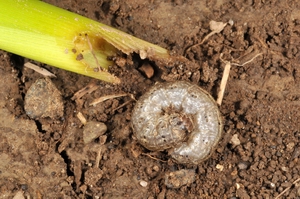 Captures of adult moths in some areas of the state have been high, so it's worthwhile for producers to take a walk through fields when corn starts spiking, as in the early stages, to look for black cutworm damage," said Professor Krupke.
Captures of adult moths in some areas of the state have been high, so it's worthwhile for producers to take a walk through fields when corn starts spiking, as in the early stages, to look for black cutworm damage," said Professor Krupke.Black cutworm moths are brown with dark, dagger-shaped markings on their forewings. The larvae are light gray to black and vary in size from one-eighth of a millimeter to 2 inches. Larvae can destroy young corn plants by cutting through stalks.
Black cutworm moths overwinter in the milder states surrounding the Gulf of Mexico, but migrate north to Indiana from late February to June.
Fields with abundant annual weeds or cover crops are ideal places for moths to lay their eggs, so farmers should be careful to keep the co-occurrence of cover crops and corn crops to a minimum; this year's rains made that difficult.
Young worms with about 25 days left to feed will cut small notches into corn leaves. While the damage is usually not economically significant, this is the stage to try to get rid of the pests. Older worms are harder to control and will ruin crops by cutting into the plants.
Growers are likely to notice signs of feeding once populations reach two black cutworm larvae per 100 plants. Each worm has the potential to cut four plants in its lifetime.
"As soon as growers see damage on emerging corn and find the black cutworm levels over threshold in the area, they should treat," Professor Krupke said.
Most damage is done at night. During the day, black cutworms can be found under dirt clods and just beneath the soil surface within 2-3 inches of the last plant damaged.
Insecticides can be used to control black cutworm damage, but these chemicals have limitations. Seed-applied insecticides can suppress populations somewhat, but should not be relied upon as a preventative measure that will keep black cutworms at bay, particularly when populations are high.
Entomologists track male black cutworm moths to gauge the threat to the state's corn crops using traps baited with synthetic versions of female-produced pheromones. The traps are limited in that they don't predict damage because they don't catch female moths, which lay the eggs that damage crops.
Although the pheromone traps give a good presence/absence indication of which counties might expect to find black cutworms, it is impossible to predict if individual fields will be infested, so field scouting is essential.





